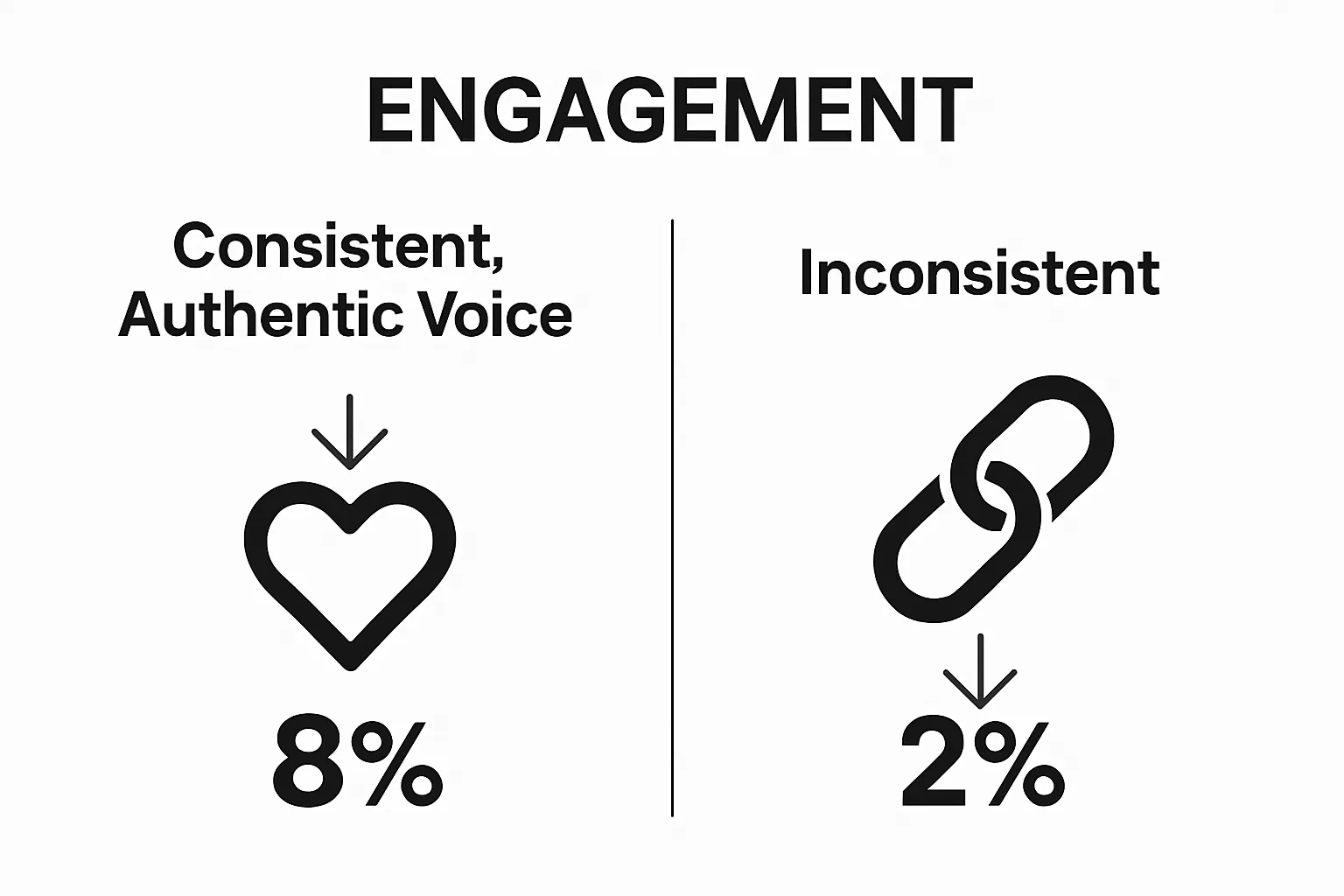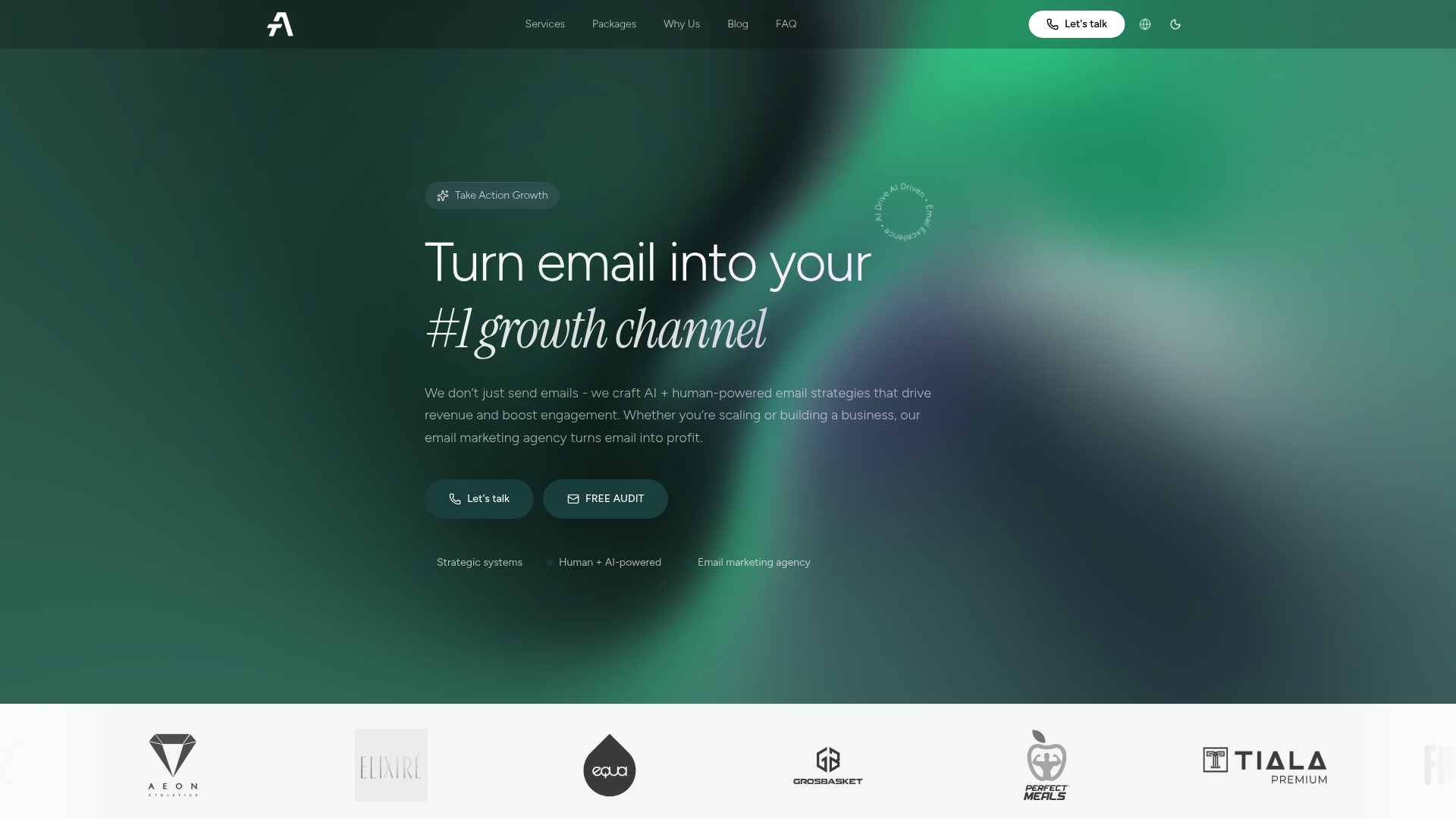Understanding Brand Voice Development for DTC Growth
A brand’s voice is more than just what it says and it is the way customers recognize and emotionally respond to a company in every interaction. Sounds straightforward, right? Actually, brands that use a consistent voice across all channels see up to 23 percent higher revenue compared to those that do not. This means the right words do not just build loyalty. They build real business results.
Table of Contents
- What Is Brand Voice Development And Its Importance?
- The Role Of Brand Voice In Customer Connection
- Key Elements That Define Your Brand Voice
- How Brand Voice Influences Customer Engagement
- Real-World Examples Of Effective Brand Voice Development
Quick Summary
| Takeaway | Explanation |
|---|---|
| Develop a consistent brand voice | Consistency across all communication increases audience recognition and loyalty. |
| Connect emotionally with customers | Utilize emotional intelligence to resonate with customer values and aspirations. |
| Prioritize authenticity in messaging | Authenticity builds trust, making interactions feel personal and genuine. |
| Use clear tone and language | Tailor your tone to match your audience, using relatable language to enhance engagement. |
| Craft narratives that engage | Compelling stories create deeper connections, transforming transactions into relationships. |
What is Brand Voice Development and Its Importance?
Brand voice development represents a strategic process of creating a distinctive, consistent communication approach that defines how a brand expresses its personality, values, and unique identity across all customer interactions. At its core, brand voice serves as the verbal and written representation of a company’s character, enabling direct emotional connections with target audiences.
The Fundamental Elements of Brand Voice
Think of brand voice as the personality your business communicates through language. Learn more about brand identity principles reveals that successful brand voice development goes beyond mere word selection. It encompasses tone, language style, emotional resonance, and communication consistency.
Key fundamental elements include:
- Authenticity in communication
- Consistent messaging across platforms
- Clear representation of brand values
- Emotional connection with audience
Why Brand Voice Matters for DTC Brands
For direct-to-consumer (DTC) brands, brand voice becomes a critical differentiator in a crowded digital marketplace. According to Nielsen Marketing Research, consistent brand presentation across all platforms increases revenue by up to 23%. By establishing a memorable, distinctive voice, brands can:
- Cut through digital noise
- Build stronger customer loyalty
- Create memorable brand experiences
- Distinguish themselves from competitors
Brand voice development transforms communication from transactional to meaningful, turning simple interactions into opportunities for deeper customer engagement. It allows businesses to speak directly to their audience’s emotions, values, and aspirations, creating a sense of genuine connection that transcends traditional marketing approaches.
The Role of Brand Voice in Customer Connection
Customer connection transcends traditional marketing strategies by creating profound emotional resonance through strategic communication. Brand voice serves as the critical bridge that transforms transactional interactions into meaningful relationships, allowing businesses to communicate beyond product features and connect on a deeper psychological level.
Emotional Intelligence in Brand Communication
Explore advanced marketing storytelling techniques demonstrate that emotional intelligence plays a pivotal role in brand voice development. By understanding and addressing customer emotions, brands can craft narratives that resonate authentically and build genuine trust.
Key emotional connection strategies include:
- Demonstrating empathy through language
- Reflecting customer aspirations
- Creating relatable brand personas
- Maintaining consistent emotional tone
Psychological Foundations of Brand Connection
According to Harvard Business Review, consumers are 71% more likely to purchase from brands that communicate with emotional intelligence. This psychological connection happens through:
- Triggering positive emotional responses
- Establishing trust through transparent communication
- Creating sense of shared values
- Building narrative that customers want to be part of
Successful brand voice development is not about speaking to customers but speaking with them. It requires deep understanding of audience psychology, cultural nuances, and the subtle art of creating communication that feels personal, authentic, and genuinely engaging. By mastering this approach, brands transform from mere product providers to trusted companions in their customers’ journeys.
Key Elements that Define Your Brand Voice
Brand voice is not a one-dimensional concept but a complex combination of communication strategies that collectively represent a company’s unique personality. Understanding the fundamental elements that craft a distinctive voice enables brands to create more meaningful and resonant interactions with their audience.
Tone and Language Characteristics
Discover strategies for maintaining brand consistency highlights that tone and language form the foundational pillars of brand voice. These elements encompass the emotional register and linguistic style through which a brand communicates its core message.
Critical tone and language characteristics include:
- Formal versus conversational communication style
- Complexity of language
- Emotional temperature of messaging
- Cultural and demographic alignment
Core Personality Dimensions
According to Personality Branding Research, successful brand voices are built on recognizable personality dimensions that create predictable and trustworthy communication patterns. These dimensions typically include:

- Sincerity
- Excitement
- Competence
- Sophistication
- Ruggedness
Effective brand voice development requires a nuanced understanding of how these personality dimensions translate into concrete communication strategies.
The following table summarizes the key personality dimensions that commonly define a brand voice and describes how each dimension is typically expressed in brand communication.
| Personality Dimension | Description |
|---|---|
| Sincerity | Genuine, honest, and transparent communication |
| Excitement | Energetic, playful, and spirited language |
| Competence | Reliable, knowledgeable, and skilled messaging |
| Sophistication | Elegant, refined, and upscale expression |
| Ruggedness | Tough, bold, and outdoorsy tone |
How Brand Voice Influences Customer Engagement
Customer engagement represents a complex interaction between brand communication and audience perception. Brand voice acts as the critical mechanism that transforms passive audience observation into active, emotional participation, creating meaningful connections that transcend traditional transactional relationships.
Psychological Triggers of Engagement
Discover techniques for storytelling that naturally engages customers reveals the profound psychological mechanisms through which brand voice influences customer behavior. Engagement occurs when communication triggers specific emotional and cognitive responses that make customers feel personally connected.
Key psychological engagement triggers include:
- Recognition of shared values
- Sense of authentic representation
- Emotional resonance with brand narrative
- Perceived understanding of customer needs
Metrics of Voice-Driven Engagement
According to Sprout Social Index, brands with consistent and authentic communication experience significantly higher engagement rates. This engagement manifests through:

- Increased social media interaction rates
- Higher customer retention percentages
- More meaningful customer feedback
- Enhanced brand loyalty metrics
Effective brand voice goes beyond mere communication it becomes a strategic tool for building deep, lasting customer relationships. By understanding the intricate balance between emotional intelligence, linguistic precision, and authentic storytelling, brands can create voices that do not just speak to customers but genuinely connect with them on a fundamental human level.
Real-World Examples of Effective Brand Voice Development
Brand voice development transforms abstract communication strategies into tangible, memorable experiences that distinguish companies in competitive markets. Successful implementations demonstrate how thoughtful linguistic approaches can create profound connections with target audiences.
Technology and Direct Communication
Learn about building customer loyalty for small businesses reveals how innovative brands leverage distinctive communication styles. Technology companies like Slack and Mailchimp have pioneered conversational, approachable brand voices that humanize complex digital services.
Key characteristics of their communication approach include:
- Using informal, friendly language
- Incorporating humor and wit
- Simplifying technical concepts
- Creating relatable brand personalities
Consumer Brands and Emotional Storytelling
According to Harvard Business Review, brands like Dove and Nike have masterfully developed voices that transcend product marketing. Their communication strategies focus on:
- Championing social causes
- Representing diverse human experiences
- Creating emotionally resonant narratives
- Aligning brand messages with broader cultural conversations
These exemplary brands demonstrate that effective brand voice is not about speaking at customers but engaging with them authentically. By understanding their audience’s deeper aspirations, values, and emotional landscapes, they create communication that feels less like marketing and more like meaningful dialogue.
This table highlights the key differences between technology brands and consumer brands in their approach to brand voice development, focusing on specific characteristics and communication strategies discussed in the article.
| Brand Category | Communication Approach | Key Characteristics | Example Brands |
|---|---|---|---|
| Technology Brands | Direct & Conversational | Informal language, humor, simplify complex concepts, relatability | Slack, Mailchimp |
| Consumer Brands | Emotional Storytelling | Champion causes, emotional narratives, cultural alignment | Dove, Nike |
Ready to Transform Your Brand Voice Into Measurable Growth?
Have you noticed how a well-developed brand voice can turn casual customers into loyal advocates, yet struggle to make every email feel authentically yours? Many DTC brands face the challenge of blending their unique personality with data-driven strategies to increase engagement and revenue. If connecting deeply with your audience and maintaining consistency across all customer interactions feels out of reach, it is time for a partner who makes your brand voice work for your bottom line.

Take Action specializes in aligning your distinct brand voice with proven Klaviyo-powered email automation and retention strategies. We help you:
- Increase open and click rates with messaging that speaks directly to your customers
- Recover abandoned carts using tailored flows that reflect your brand’s values
- Scale your DTC business with seamless, AI-enhanced retention campaigns that never lose your identity
Start optimizing your email channel as the core driver of your growth. Discover how we can leverage brand voice to unlock customer loyalty and sustainable revenue—visit Take Action and see real examples or request your custom email growth audit today.
Frequently Asked Questions
What is brand voice development?
Brand voice development is the strategic process of crafting a unique and consistent communication style that reflects a brand’s personality, values, and identity across all customer interactions.
Why is brand voice important for direct-to-consumer (DTC) brands?
Brand voice is crucial for DTC brands as it helps them stand out in a saturated market, fosters customer loyalty, and creates memorable brand experiences by building a genuine emotional connection with the audience.
How can emotional intelligence enhance brand voice?
Emotional intelligence enhances brand voice by allowing brands to understand and respond to customer emotions. This involves crafting narratives that resonate authentically with the audience, demonstrating empathy, and reflecting the customers’ aspirations.
What are the key elements that define a brand voice?
The key elements of brand voice include tone and language characteristics, emotional resonance, consistency across platforms, and core personality dimensions such as sincerity, excitement, competence, sophistication, and ruggedness.
Recommended
- Understanding the Importance of Brand Voice for eCommerce | Take Action Blog | Take Action
- Master Branding for Small Businesses: Build Loyalty in 2025 | Take Action Blog | Take Action
- How to Tell Your Brand Story to Engage Customers Effectively | Take Action Blog | Take Action
- 7 Branding Mistakes to Avoid for Your Ecommerce Brand | Take Action Blog | Take Action
- Understanding Content Storytelling for Business Growth
